Q&A – Ask Neil: February 23, 2023
(Please read these instructions carefully.)
Before you post your question, please look at recent issues to see if someone else has already asked it. You might find your answer there.
How to submit your question…
• Click the link provided below to post your question. After you submit your question, a new window will pop up giving you the address to which you can e-mail a photo to accompany your question. Clear, medium-resolution photos. (Try to avoid low-res thumbnail photos, please, in case I have to zoom in to see things.)
• Click here to post your question.
• Please only post your question one time.
• One question per reader, please.
• Please use this only for posting questions – not for standard emails.
• Watch for your answer in the following week’s e-gardens.
• I choose those of greatest general interest. For example, plant IDs seldom make the cut.
• I must have your first name or initials.
• I must have your city or county. (Texas is a very large state.)
QUESTION 1
WHAT CAUSED UNUSUAL GROWTH ON CHINESE PISTACHIO?
Question: My Chinese pistachio is 7 years old. Last spring the northwest portion of the tree budded out strangely and the growth it produced was also quite odd. The remaining 75 percent of the tree was completely normal. What happened? Betty L., Aubrey, Denton Co.

Answer: I can’t tell for certain just from the stubby twigs. It could have been due to a “glancing blow” of a weedkiller on that side of the tree. That can happen when a weed-and-feed product is applied on one side of a tree or when a broadleafed weedkiller has been sprayed only on one side. It could also be due to damage on that side of the trunk, perhaps brought on by sunscald when the tree was younger or being nicked by a mower wheel or line trimmer. Examine the entire tree. The problem very well may be somewhere else in the tree and just manifesting in these twigs. You may even have to wait until the tree has leafed out this spring to get the best possible idea.
QUESTION 2
SUGGESTION ON LAST WEEK’S SECOND QUESTION – SEPARATING TWO SHRUBS THAT HAVE GROWN TOGETHER.
Question: The reader asked about separating two shrubs, one a volunteer that had come up within another landscape shrub. I have had good luck by soaking the root ball, then washing away the soil, then teasing the roots apart carefully. Robert H., Irving.
Answer: I’ve done that as well. In fact, that’s how we often divide congested perennials such as daylily root systems. However, these shrubs, as judged from the photo, were several feet tall and very well established in the bed. I fear that removing them so that their roots could be washed clean would put both plants at risk. They would, at a minimum, have to be thinned and pruned back by 50 percent or more to compensate for the roots lost in the digging and washing.
QUESTION 3
WILL ASIAN JASMINE THAT WAS ALREADY BROWN FROM A FUNGUS, NOW ALL BROWN FROM THE COLD, COME BACK?
Question: All of the Asian jasmine around me is brown. Could it come back from the hard freeze? Some of mine was already brown from a fungus. Should we just wait? Anne W., Dallas.
Answer: That is totally cold damage. (Unless you had some leftover drought damage from last summer and early fall.) I’ve been growing and involved with Asian jasmine for 60 years and I have never seen even one insect or evidence of fungus in all that time. Trim it back to within 2 to 3 inches of the ground. It will look quite bare, but if you put an all-nitrogen lawn food on it followed by a deep soaking it will head into spring with a beautiful flurry of new growth.
QUESTION 4
WHEN SHOULD YOUNG RED OAK AND LIVE OAK TREES BE TRIMMED?
Question: When should I trim my young red oak and live oak trees? Both are about 10 feet tall and around 3 years old. The trunk on each is no more than 1-1/2 inch in diameter. There are numerous bottom limbs that are really low. Bill B., Bridgeport.
Answer: You could prune them now. Each of those bottom limbs should be cut virtually flush with the trunk and sealed immediately with pruning paint. Come up the trunk no higher than 4 feet (40 percent of the way from the ground to the top of each tree) to maintain good balance. (In reality, pruning of oaks is supposed to be finished by Valentine’s Day to avoid the chance of spread of the oak wilt fungus. It becomes active in warming spring weather. However, by sealing the cuts immediately you should be able to bypass that risk. If you prefer to wait, the accepted pruning time comes back around in mid-July.)
QUESTION 5
WHY ARE MY TOMATO SEEDLINGS’ LEAVES CURLING DOWN?
Question: I’ve been starting tomatoes from seed for several years. The last few have seen the same issue: leaves turning down and curling under, but still green. The Internet sites I’ve read only mention leaves curling up and turning brown. What’s happening? Wayne H., Alvarado.
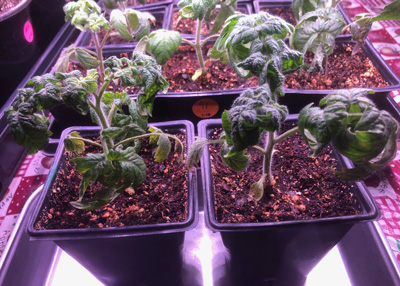
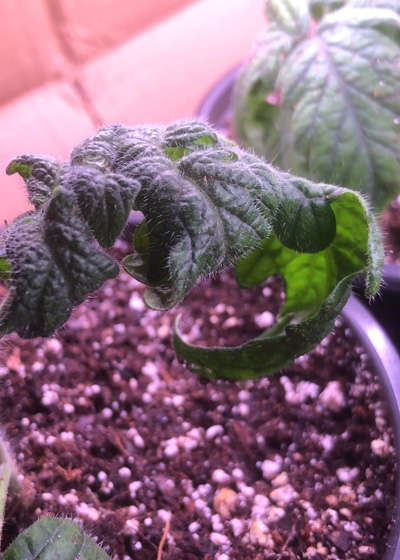
Answer:
This takes me back to a really interesting Plant Physiology class I had at A&M as a freshman. We grew cotton seedlings in a growth chamber where they were surrounded by fluorescent lights on all sides 16 hours per day. Each group of plants was given nutrient supplies containing all essential elements except one. We were able to see the effects of not enough nitrogen, phosphorus, potassium, iron, sulfur, manganese, molybdenum, boron, and so on. This looks like phosphorus deficiency to me. Did you change your source of fertilizer the year that this problem began showing up?
I would also think back to the types of tubes you have in the fixtures and whether you might have changed either them or the amount of time that you operate them beginning when the plants started to change.
I sent your photos to Kenneth Cranfill, a grower friend who has produced hundreds of thousands of tomato transplants over the past 40 springs. He suggested we compare the symptoms of epinasty. I told Kenneth he was way smarter than I am, and I got busy doing my research. Here are a couple of links that might be of help. They suggest you consider ethylene, excessively wet potting soil, or boron deficiency as the three most common examples (plus drifts of broadleafed herbicides for outdoor plants). https://www.thedailygarden.us/garden-word-of-the-day/epinasty
Or, in different words:
https://www.encyclopedia.com/earth-and-environment/ecology-and-environmentalism/environmental-studies/epinastic-growth
Or, in still different words:
https://www.gardenanswers.com/plant-diseases/epinasty-of-tomato-2/
Having now typed all of that up, I think Kenneth wins the prize!
QUESTION 6
WHAT SHRUBS WOULD SURVIVE IN 100-DEGREE HEAT AND SINGLE DIGIT WINTERS?
Question: I’ve lost many 3- to 4-foot shrubs to the extreme cold of the past few years. Can you recommend any that can take both our 100-degree summer temperatures and the single-digit winter weather? Preferably evergreen, but ones that come back from their own roots at least. I lost pittosporums and rosemary plants in the past two winters. Carol D., Brenham.
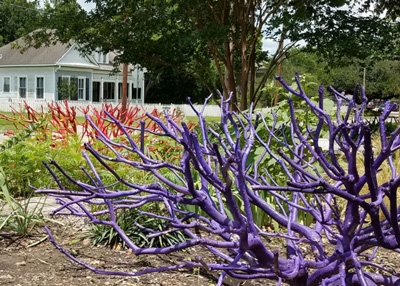
Answer: First of all, hats off for the creative stems on your “deciduous” shrubs. I’m still trying to figure them out! There are several excellent options. Hollies are always top choices. In that size range, dwarf yaupon, dwarf Chinese, Carissa and dwarf Burford hollies. Also dwarf and compact nandinas. Tam junipers (full sun only). Green Beauty boxwood (and other types that hold their green foliage all winter). You happened to have two plant types that are less winter-hardy than most, and you hit two really bad cold spells.
QUESTION 7
WOULD A ROOT BARRIER PREVENT BALD CYPRESS KNEES HERE?
Question: I have three mature bald cypress trees only 10 feet away from my house. Would a root barrier prevent knees, or would the knees just grow over the barrier? Gigi M., Frisco.

Answer: Bald cypress roots are extremely strong. I would consult with a certified arborist about where a barrier could be installed and whether it would have the strength to hold back the roots. (They would push into and through the retainer, not go over it.) It certainly wouldn’t hurt to try, if for no other reason than to keep roots from going beneath your house. Your trees are still comparatively young. Truly mature bald cypresses grow to be 24 to 30 inches in diameter in the Metroplex and much larger in other parts of the state.
QUESTION 8
WHAT ARE THESE GROWTHS ON LIMBS OF SHUMARD RED OAK?
Question: What are these growths encircling the limbs of my Shumard red oak? Some are tennis ball-sized, much larger than the galls I’m used to seeing on my live oaks. They are rock-hard and can’t be crushed by hand-squeezing. Is there any call to action? Jim B., Missouri City, Fort Bend County.
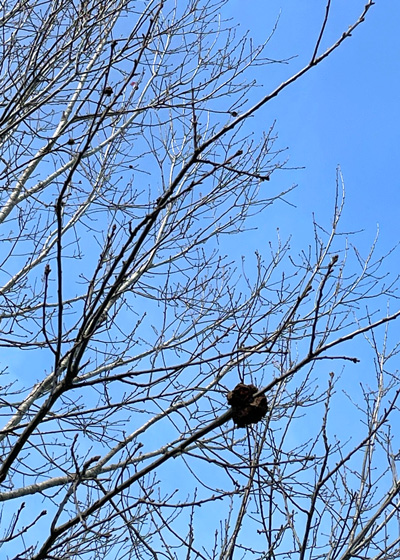
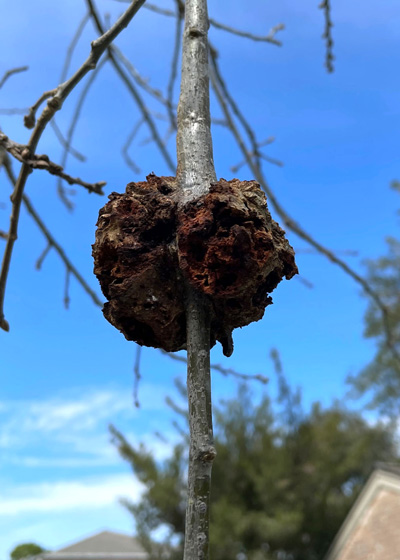
Answer: My immediate reaction was that it looked like crown gall. Then I realized that crown gall is, by its name, usually down around the “crown” of the plant, that is, where its stem enters the ground. So, I did some online searching using key words “university plant pathology Quercus stem gall.” I figured “plant pathology” would get me out of the scores of different insect galls that attack oaks (genus Quercus). By including the words “university” and “Quercus” I was trying to get away from informal home remedies.
My first match was from the University of Maine for Phomopsis gall on oaks.
Then, almost immediately, I was pushed back into insect galls with the Missouri Botanical Garden’s page on gouty oak gall and horned oak gall. See their photos and read their descriptions. This really does look like it could be a match.
You might try cutting through one of the larger galls with a small saw as you hold the gall in a vise. If you can see evidence of larval activity within it, that would indicate that it’s an insect gall. However, you might get a better answer by contacting the Texas A&M Plant Disease Diagnostic Lab and letting them look at and perhaps culture a sample. There would be a fee for doing so, but you would know for sure.
One common thread through both of those websites to which I linked you above is that they say that those galls do not put the tree at immediate risk. There usually isn’t much you can do to treat for galls, so you might just have a certified arborist keep an eye on the overall vigor of the tree. Should it weaken dramatically, then you could have it removed.
QUESTION 9
WHAT SHOULD I DO WITH MY CRAPE MYRTLE?
Question: My crape myrtle is two years old. All of its 5 or 6 trunks were tangled and growing together. I pruned down to the best three trunks, but they’re still twisted and scarred. Should I leave them, cut them back to the ground or do something else? Kevin A., Van Alstyne.
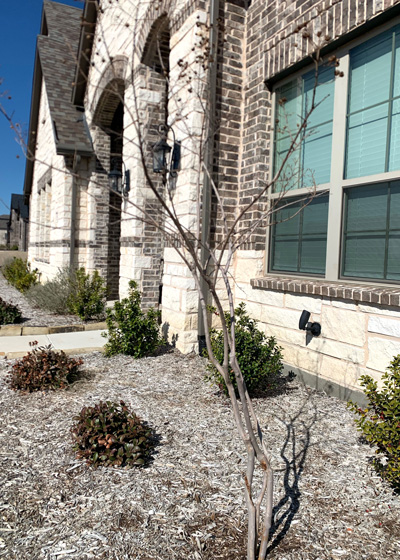
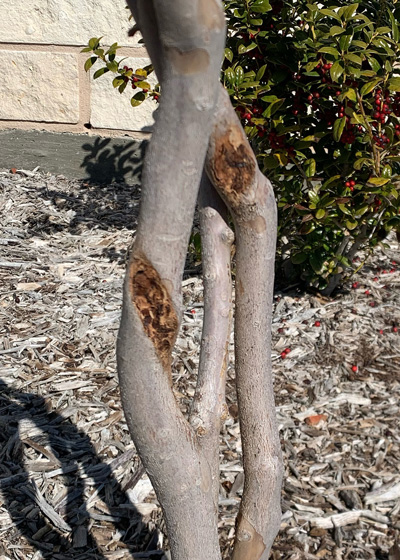
Answer: You have obviously heard and hopefully seen my recommendation of cutting disfigured crape myrtles completely to the ground, leaving just 1 inch of trunk to mark their locations. The plant will send up new sprouts from each old trunk. You would then thin out the many new shoots to leave only 7 or 9 toward the end of this growing season. Then, once those trunks have become strong enough to stand on their own, you could trim off the extras, leaving just 3 or 5 (odd numbers are more attractive visually) to become the new trunks. You’ll have a handsome new tree years faster than you would if you tried to prune and retrain the tree as it sits now. There is active decay in the one trunk. It’s not going to be strong anyway.
QUESTION 10
DID CHINCH BUGS CAUSE THIS DAMAGE LAST SUMMER?
Question: I saw your reply last week. I have a similar question before I resod. Did chinch bugs cause this St. Augustine to die in these bare patches? How can I stop them from killing it out there again? B.B., Frisco.
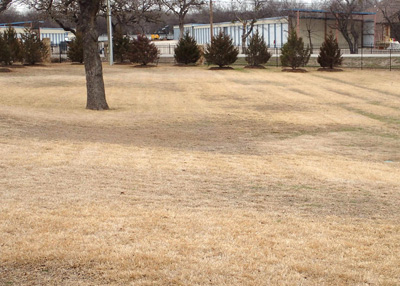
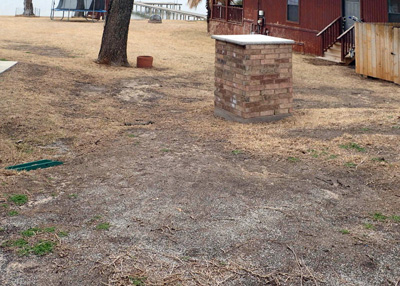
Answer: We are 6 or 7 months beyond when chinch bugs, if present, would have been involved with your lawn. It’s impossible after that much time to tell if they were responsible for this thinning and die-out. That said, I will offer an educated guess that they either weren’t the sole contributors or they weren’t involved at all. Chinch bugs are always going to be in the hottest, sunniest part of your lawn.
It looks like parts of this area are shaded. Meanwhile, areas that appear to be in full sun look fine. Be certain that the affected areas are receiving at least 6 or 7 hours of direct sunlight daily during the growing season. If not, shade is your culprit. You may need to plant a shade-tolerant groundcover like purple wintercreeper euonymus in this area if it’s too dark for St. Augustine.
Be sure, too, that the area is uniformly watered. There’s enough slope in the closer photo that the water might be running off. That’s the best I can offer from what I can see.
